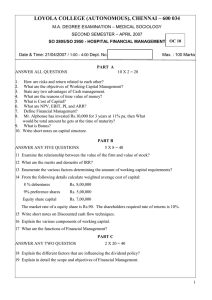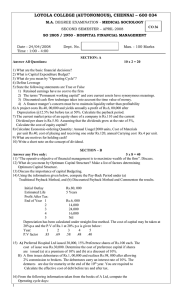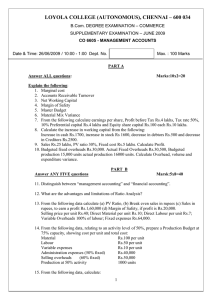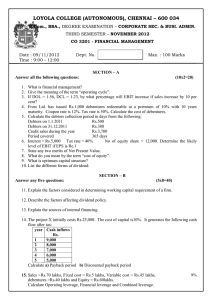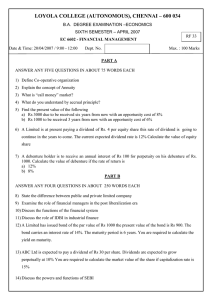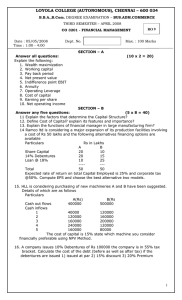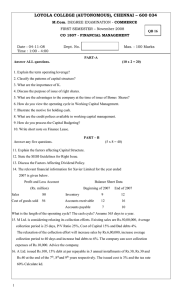LOYOLA COLLEGE (AUTONOMOUS), CHENNAI – 600 034
advertisement
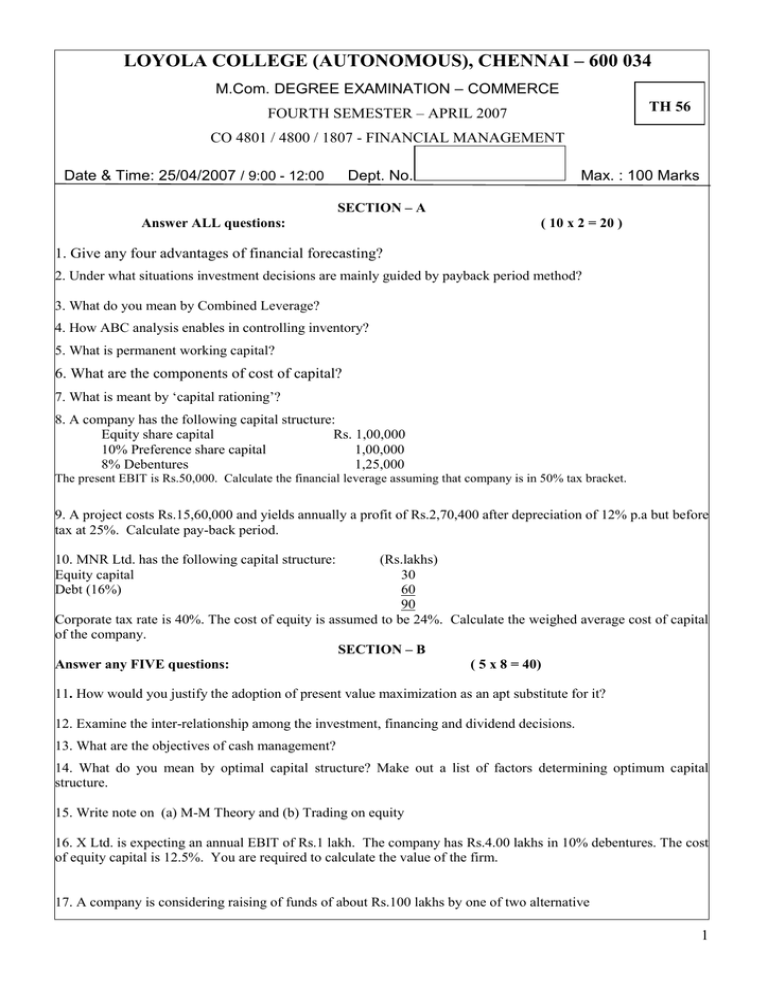
LOYOLA COLLEGE (AUTONOMOUS), CHENNAI – 600 034 M.Com. DEGREE EXAMINATION – COMMERCE TH 56 FOURTH SEMESTER – APRIL 2007 CO 4801 / 4800 / 1807 - FINANCIAL MANAGEMENT Date & Time: 25/04/2007 / 9:00 - 12:00 Dept. No. Max. : 100 Marks SECTION – A Answer ALL questions: ( 10 x 2 = 20 ) 1. Give any four advantages of financial forecasting? 2. Under what situations investment decisions are mainly guided by payback period method? 3. What do you mean by Combined Leverage? 4. How ABC analysis enables in controlling inventory? 5. What is permanent working capital? 6. What are the components of cost of capital? 7. What is meant by ‘capital rationing’? 8. A company has the following capital structure: Equity share capital Rs. 1,00,000 10% Preference share capital 1,00,000 8% Debentures 1,25,000 The present EBIT is Rs.50,000. Calculate the financial leverage assuming that company is in 50% tax bracket. 9. A project costs Rs.15,60,000 and yields annually a profit of Rs.2,70,400 after depreciation of 12% p.a but before tax at 25%. Calculate pay-back period. 10. MNR Ltd. has the following capital structure: Equity capital Debt (16%) (Rs.lakhs) 30 60 90 Corporate tax rate is 40%. The cost of equity is assumed to be 24%. Calculate the weighed average cost of capital of the company. SECTION – B Answer any FIVE questions: ( 5 x 8 = 40) 11. How would you justify the adoption of present value maximization as an apt substitute for it? 12. Examine the inter-relationship among the investment, financing and dividend decisions. 13. What are the objectives of cash management? 14. What do you mean by optimal capital structure? Make out a list of factors determining optimum capital structure. 15. Write note on (a) M-M Theory and (b) Trading on equity 16. X Ltd. is expecting an annual EBIT of Rs.1 lakh. The company has Rs.4.00 lakhs in 10% debentures. The cost of equity capital is 12.5%. You are required to calculate the value of the firm. 17. A company is considering raising of funds of about Rs.100 lakhs by one of two alternative 1 methods – 14% institutional term loan and 13% non-convertible debentures. The term loan option would attract no major incidental cost. The debentures would have to be issued at a discount of 2.5% and would involve cost of issue of Rs.1 lakh. Advice the company as to the better option based on the effective cost of capital in each case. Assume a tax rate of 50%. 18. The earnings per share of a company are Rs.16. The market rate of discount applicable to the company is 12.5%. Retained earnings can be employed to yield a return of 10%. The company is considering a pay-out of 25%, 50% and 75%. Which of these would maximize the wealth of shareholders? SECTION – C Answer any TWO questions: ( 2 x 20 = 40 ) 19. A firm can purchase for Rs.2,500 an asset having life of 5 years after which its salvage value is Rs.500. The firm provides depreciation on straight line method. Purchasing and using the asset will increase the firm's expected revenues by Rs.1,500 per year and will raise its expected operating expenses (not including depreciation and interest) by Rs.700 per year. The corporate tax is 50% and the cost of capital of the firm is 10%. The firm can also lease the asset for a yearly rental of Rs.650. The incremental revenue will be same at Rs.1,500 per year and the increase in firm's expected non-depreciation expense is Rs.600 per year only. Evaluate the proposals. 20. Two projects M and N which are mutually exclusive are being under consideration. Both of them require an investment of Rs.1,00,000 each. The net cash inflows are estimated as under : Year 1 2 3 4 5 M Rs. 10,000 40,000 30,000 60,000 90,000 N Rs. 30,000 50,000 80,000 40,000 60,000 The company's targeted rate of return on investments is 12%. You are required to assess the projects on the basis of their present values, using (1) NPV method and (2) Profitability index method. Present values of Re.1 at 12% interest for five years are given below: 1st year : 0.893; 2nd year : 0.797; 3rd year : 0.712; 4th year : 0.636; 5th year : 0.567. 21. The cost sheet of PQR Ltd. provides the following data : Raw material Direct Labour Overheads (including depreciation of Rs.10) Total cost Profits Selling price Cost per unit Rs.50 20 40 110 20 130 Average raw material in stock is for one month. Average material in work-in-progress is for ½ month. Credit allowed by suppliers: one month; credit allowed to debtors : one month. Average time lag in payment of wages : 10 days; average time lag in payment of overheads 30 days. 25% of the sales are on cash basis. Cash balance expected to be Rs.1,00,000. Finished goods lie in the warehouse for one month. You are required to prepare a statement of the working capital needed to finance a level of the activity of 54,000 units of output. Production is carried on evenly throughout the year and wages and overheads accrue similarly. State your assumptions, if any, clearly. ****** 2
